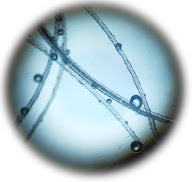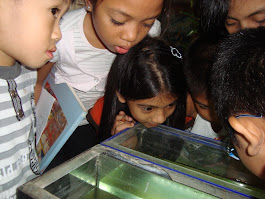Home Aquarium
- Microcosm of Freshwater Ecosystem
Dr Abe V Rotor
Part 1 - Natural Aquarium -
Keyhole View to Magnificent Creation

There was no electricity then, and therefore there were no motorized air pumps and filters, aquarium lights, oxygen generators, and the like, which we use in aquariums today. Yet the aquarium in those days was beautiful in its own natural way, and it was simple and easy to maintain.

Red Poecilia in a glass aquarium at home.
When I was a kid I used to visit my cousin who later joined a religious order (Sister Francisca Rotor, SPC) just to watch and ponder on her glass aquarium sitting on a window facing the northeast. The sun shone through the glass, its rays splitting into the prism of the rainbow spreading on the aquatic plants, and the playful goldfish. Bubbles hanged on the glistening Elodea and Hydrilla plants, then rose slowly to the top faintly hissing and popping. I now understand that these bubbles are pure oxygen, the by-products of photosynthesis.
At the bottom and side of the aquarium were small snails which did the job of the janitor fish as gleaners and cleaners. Snails scrape off algal crust and being saprophytes too, convert organic matter into detritus which is equivalent to compost - in turn provides nutrition to the aquatic plants. Carbon dioxide emitted by the fish and snail is used by the plants for photosynthesis, and in the process produce sugar, and oxygen as by-product. Sugar is subsequently converted into other organic compounds which are necessary for the plants to grow and gain biomass. Being herbivores fish and snail depend upon the plant.
The secret of a stable aquarium is balanced gas exchange and organic-inorganic cycle. Once this is attained we can say the aquarium is a "balanced ecosystem," a microcosm of a pond or lake.
Manang Madre aquarium soon led me to search for great minds and their works, among them, Aristotle's Natural History, Darwin's Theory of Evolution, Oparin's Beginning of Life, Cousteau's Oceanography, EO Wilson's Sociobiology, Leeuwenhoek's
Microscopy, and Henry David Thoreau's Treatise of Nature and Man.
On the other hand I taught my students to build aquariums without any electrical gadget, telling them, "In any experiment, understand and apply the laws of nature."
Why don't you put up a project in your home or school, and replicate Manang Madre's natural aquarium? It is peeping through the keyhole of magnificent creation. ~
Discovering a wonderful world under the sea
Characteristics of a Natural Aquarium
- A natural aquarium is a miniature pond, lake, or sea.
- The basic principle is conversion of the sun's energy into food and oxygen by algae and plants (photosynthesizers).
- Food and oxygen are important to fish and other animals.
- In return, the animals give off "waste" as nutrients and carbon dioxide important to plants.
- A natural aquarium therefore is a simple ecosystem, balanced environment.
- Like any ecosystem, its balance depends on healthy interrelationship of the living and non-living world.
- The organisms are classified into producers (plants, algae), and consumers (fish, snails), and decomposers (bacteria)
- Balance is dynamic, it changes, but nature guides it to attain stability or homeostasis.
- Energy flow goes through the food chain, food web, food pyramid.
- Humans are part of this system, and has assumed dominance over other organisms.
- Nature takes care of itself even without man. Thus, forests, coral reefs, and the like, are best maintained without man's intervention.
- On the other hand it is man that may destroy this natural balance through pollution, over fishing chemical farming, deforestation - and global warming, which is a consequence of man's increasing number and affluence. ~
I loved watching the guppies in an old fashioned aquariumsans any gadget for lighting, filter, and fancy screen;the sun, the provider of food and oxygen through the algaeclinging on rock, and snails living off the glass clean.I was a kid then eager to discover the mysteries of nature;a little of Darwin, Linnaeus, and Arthur Doyle I sought,of Fleming's serendipity and Leeuwenhoek's microscopy,seeing their images in an aquarium my cousin taught.It was schooling, experimenting, and above all, dreaming,it took me to a little Smithsonian, to a niche in biology,archive of living history, the microcosm of the living world,to the ends of the world, far from man's technology. - avrotor
Basic microscopy for kids in the neighborhood. Bubbles of Oxygen, by-product of photosynthesis cling on the alga before they are dissolved in water for the use of fish, or released into the atmosphere for humans and animals. Children's workshop at home in Lagro, QC, organized and conducted by my children, Marlo, Anna and Leo.
Microscopic community nestles on the alga. It is made up of protists living in a complex interrelationship, and interaction of energy and matter, in dynamic balance. Practical microscopy using ordinary compound microscope and camera.
-----------------------------------
To me, Manang Madre's aquarium was a laboratory, the curious kid that I was. It introduced me into a realm I would be devoting much of my time as biologist. It left an indelible mark of nature's self-contained system - the dynamic balance that keeps order and harmony in nature which scientists call homeostasis. ~
---------------------------------------
Part 2 Hobby: Raising pet fish in the city
Albino Oscar fish in a glass aquarium. The Albino Tiger Oscar (Astronotus ocellatus), is also known as the Marble Cichlid or Velvet Cichlid,
At home in Lagro, QC. Photos by the author.


My pet fish grew and grew, until they became overcrowded. Now electricity and water are very expensive. But is it worth the hobby?
Yes, indeed.
How I love the relaxing sound of a little fountain, the gurgling of a bigger one, the splash the fish make in their play, and at feeding time. Now and then they come close to be touched. A scratch on the back like any pet.
What a morning to greet them. And they to meet you. Coffee and newspaper would not be complete if you are away from their company. So move your reclining chair close. Who say you cannot relax in the city anymore? Not with my pacu.
And if you need exercise, carry a bucket or two of freshwater to replace evaporation everyday. Yes, everyday. Clean the pumps of clog now and then. Scrape off overgrown lumot (algae), unless the janitor fish is doing it efficiently, with the help of suso (snail) while the fish are still small. By the time they weigh one kilo each, no snail will survive. By this time the janitor fish shall have grown as big to the pacu.
A garden pond is actually a small world – an ecosystem where the laws of nature are taking place to maintain a dynamic balance called homeostasis.
First, you must keep Carbon Dioxide in water as low as possible. That’s why you need an electric pump to augment the desirable level of dissolved oxygen.
Second, you must clean the pond with least disturbance. Detritus must be regularly eliminated otherwise they will continue to decompose and produce toxic gases and substances that breed unwanted microorganisms, including pathogens that kill your fish.
Third, feed them regularly and moderately with the right kind of food. I give dog food, and cat food sometimes, for a change. One good thing with these feeds is that they float and feeding is regulated. Never, never overfeed. It is better you miss a day or two than leaving unconsumed feeds.
Fourth, assign only one caretaker, better still you are the caretaker and nobody else. They are your pet anyway. Don’t allow feeding from anyone. Don’t allow children to play with your fish. Warn them of the danger, and consequence to your prized pet. They may get wild and aggressive. And get stressed.
Fifth, there is no substitute to Loving, Tender Care. Like a Florence Nightingale, visit them often, even at night, and see if they are well.
During brownout, be patient to recirculate the pond with a bucket to incorporate air. Do this for the duration of the brownout. At one time it was a whole day. Two helpers assisted me and we saved all of the fish. They were stressed all right, but they recovered.
Rainwater can be used with caution due to the effect of acid rain. I harvest rainwater for the pond at the peak of a strong rain. Tap water should be allowed to stand at least overnight before pouring it into the pond.
For all of these, is it still worth the hobby?
Indeed, it is. ~
Pacu fish in a glass aquarium before they were transferred to a garden pond where they grew more than twice their size in a year's time. Pacu is a common name used to refer to several species of omnivorous South American freshwater serrasalmid fish that are related to the piranha. Wikipedia ~














No comments:
Post a Comment